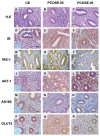Changes in the expression of insulin signaling pathway molecules in endometria from polycystic ovary syndrome women with or without hyperinsulinemia
- PMID: 20011249
- PMCID: PMC2792869
- DOI: 10.2119/molmed.2009.00118
Changes in the expression of insulin signaling pathway molecules in endometria from polycystic ovary syndrome women with or without hyperinsulinemia
Abstract
Polycystic ovary syndrome (PCOS) is an endocrine-metabolic disorder associated with insulin resistance and compensatory hyperinsulinemia. Scarce information is available on the expression of molecules involved in the insulin pathway in endometria from women with PCOS. Therefore, we examined the protein levels of insulin-signaling molecules, like insulin receptor, insulin-receptor substrate (IRS)-1, pIRS-1Y612, Akt, AS160, pAS160T642 and GLUT4 in endometria from PCOS women with or without hyperinsulinemia. Protein levels were assessed by Western blot and immunohistochemistry in 21 proliferative-phase endometria from control women (CE = 7), normoinssulinemic PCOS women (PCOSE-NI = 7) and hyperinsulinemic PCOS women (PCOSE-HI = 7). The data show no differences in the expression of insulin receptor between all groups as assessed by Western blot; however, IRS-1 and pIRS-1Y612 were lower in PCOSE-HI than controls and PCOSE-NI (P < 0.05). AS160 was detected in all analyzed tissues with similar expression levels between groups. Importantly, PCOSE-HI exhibited lower levels of pAS160T642 (P < 0.05) and of GLUT4 (P < 0.05) compared with CE. The immunohistochemistry for insulin receptor, IRS-1, Akt, AS160 and GLUT4 showed epithelial and stromal localization; IRS-1 staining was lower in PCOSE-HI (P < 0.05). In conclusion, human endometrium has the machinery for glucose uptake mediated by insulin. The diminished expression of GLUT4, as well as the lower level of pIRS-1Y612 and pAS160T642 exhibited by PCOSE-HI, suggests a disruption in the translocation of vesicles with GLUT4 to the cell surface in these patients.
Figures




Similar articles
-
Levels of Rabs and WAVE family proteins associated with translocation of GLUT4 to the cell surface in endometria from hyperinsulinemic PCOS women.Hum Reprod. 2010 Nov;25(11):2870-7. doi: 10.1093/humrep/deq232. Epub 2010 Sep 14. Hum Reprod. 2010. PMID: 20843777
-
Metformin augments the levels of molecules that regulate the expression of the insulin-dependent glucose transporter GLUT4 in the endometria of hyperinsulinemic PCOS patients.Hum Reprod. 2013 Aug;28(8):2235-44. doi: 10.1093/humrep/det116. Epub 2013 Apr 17. Hum Reprod. 2013. PMID: 23595973
-
Role of the transcriptional factors FOXO1 and PPARG on gene expression of SLC2A4 in endometrial tissue from women with polycystic ovary syndrome.Reproduction. 2010 Jul;140(1):123-31. doi: 10.1530/REP-10-0056. Epub 2010 Apr 20. Reproduction. 2010. PMID: 20406953
-
Altered Steroid Metabolism and Insulin Signaling in PCOS Endometria: Impact in Tissue Function.Curr Pharm Des. 2016;22(36):5614-5624. doi: 10.2174/1381612822666160810111528. Curr Pharm Des. 2016. PMID: 27514712 Review.
-
Metabolism and insulin signaling in common metabolic disorders and inherited insulin resistance.Dan Med J. 2014 Jul;61(7):B4890. Dan Med J. 2014. PMID: 25123125 Review.
Cited by
-
Reversing the reduced level of endometrial GLUT4 expression in polycystic ovary syndrome: a mechanistic study of metformin action.Am J Transl Res. 2015 Mar 15;7(3):574-86. eCollection 2015. Am J Transl Res. 2015. PMID: 26045896 Free PMC article.
-
Endometrial signaling pathways during ovarian stimulation for assisted reproduction technology.Fertil Steril. 2013 Sep;100(3):889-94. doi: 10.1016/j.fertnstert.2013.05.027. Epub 2013 Jun 24. Fertil Steril. 2013. PMID: 23806847 Free PMC article. Clinical Trial.
-
Exploring the relationship between osteoporosis and polycystic ovary syndrome based on bioinformatics.Medicine (Baltimore). 2022 Jun 24;101(25):e29434. doi: 10.1097/MD.0000000000029434. Medicine (Baltimore). 2022. PMID: 35758378 Free PMC article.
-
Glycogen metabolism in mink uterine epithelial cells and its regulation by estradiol, progesterone and insulin.Theriogenology. 2019 May;130:62-70. doi: 10.1016/j.theriogenology.2019.02.023. Epub 2019 Feb 27. Theriogenology. 2019. PMID: 30870708 Free PMC article.
-
Assessing and treating insulin resistance in women with polycystic ovarian syndrome.World J Diabetes. 2011 Mar 15;2(3):33-40. doi: 10.4239/wjd.v2.i3.33. World J Diabetes. 2011. PMID: 21537458 Free PMC article.
References
-
- Dunaif A. Insulin resistance and the polycystic ovary syndrome: mechanism and implications for pathogenesis. Endocrine Rev. 1997;18:774–800. - PubMed
-
- Revised 2003 consensus on diagnostic criteria and long-term health risks related to polycystic ovary syndrome. Fertil Steril. 2004;81:19–25. - PubMed
-
- Azziz R, et al. Positions statement: criteria for defining polycystic ovary syndrome as a predominantly hyperandrogenic syndrome: an Androgen Excess Society guideline. J Clin Endocrinol Metab. 2006;91:4237–45. - PubMed
-
- DeUgarte CM, Bartolucci AA, Azziz R. Prevalence of insulin resistance in the polycystic ovary syndrome using the homeostasis model assessment. Fertil Steril. 2005;83:1454–60. - PubMed
-
- Legro RS, Castracane VD, Kauffman RP. Detecting insulin resistance in polycystic ovary syndrome: purposes and pitfalls. Obstet Gynecol Surv. 2004;59:141–54. - PubMed
Publication types
MeSH terms
Substances
LinkOut - more resources
Full Text Sources
Medical

